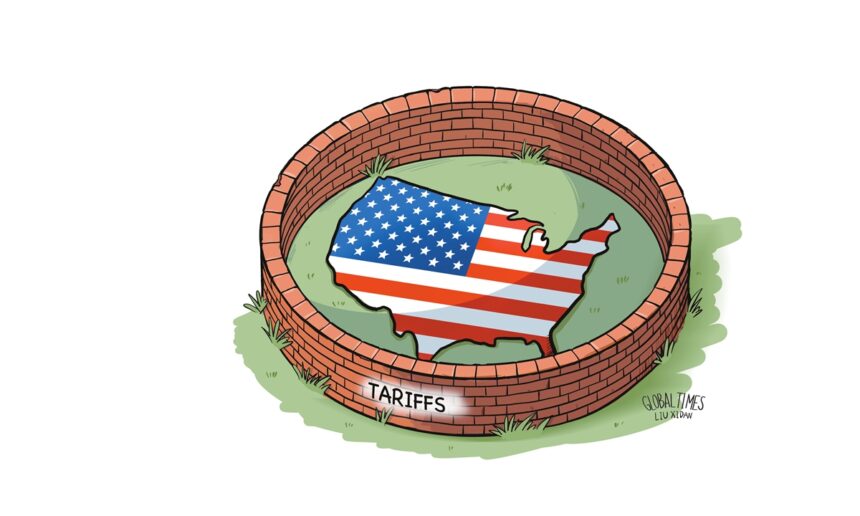By Martin Jacques-
One of the defining characteristics of US foreign policy since the beginning of China’s reform and opening-up has been its consistent underestimation of China. It never entertained the idea that China could become America’s equal, let alone surpass it. In fact, we have already arrived at the latter scenario. It is this that persuaded the Trump administration that the only solution was to junk America’s post-1945 foreign policy. America was losing and would continue to lose: a radical change of direction was needed. The first attempt was Trump 1.0. When Donald Trump won last November, a very different and far more extreme strategy was in place. It climaxed on April 9 when the Trump administration effectively called a halt on trade with China.
It was policy in extremis, what Italians might call tariffissimo, if such a word existed. When you can’t win, build a sky-high wall around your enemy, cut yourself off from them, and try to get the rest of the world to do the same.
Far from all Trump administration’s talk about “Making America Great Again,” this is nothing less than the “Great American Retreat.” It is an admission of defeat. It is a denial of the very wellsprings of human development, the constant interaction between societies and cultures that spreads learning, and the inevitable passing of the baton to rising civilizations that emerge and reshape the future. A remarkable example of this has been the last eight decades, the rise of the developing world, home to the great majority of humanity, the emergence of China and India on the global stage, and the spread of globalization. This is the world the Trump administration is revolting against. Its counter-revolution is anti-development (the huge tariffs against developing countries), anti-diversity at home and abroad, anti-globalization, anti-science (COVID-19 and climate change), and pro-white racism. It wants to close the door on the last eight decades.
Normally a strategy is conceived of as a process. Instead, the Trump administration has started at the end, with a maximalist position, a huge rupture and a headstrong approach that has been ill-thought-out. There are three reasons why it will fail. First, the trade ban will harm the US far more than it will harm China. Even though Chinese exports to the US are much larger than US exports to China, the US is far more dependent on Chinese exports than China is on US imports, for which, for the most part, it can find substitutes relatively easily. The lack of proper preparation on the US side has also been exposed by the temporary suspension of tariffs on chips, routers and other electronic products.
Second, the reaction of the bond markets, where power really lies, fired a warning shot that the Trump administration was forced to heed: The abuse of tariffs posed a serious threat to US exceptionalism. The exorbitant privilege of the dollar as the world’s reserve currency could not be taken for granted. The same warning was issued in 2008 and 2020; we can be sure that 2025 will not be the last time. The consequences of the next one could be far more drastic.
The third reason why the US “Tariff Armageddon” will fail is that China has been preparing for this scenario ever since the first Trump administration launched its anti-China crusade in 2017. If China was taken somewhat by surprise by Trump 1.0, it was extremely well-prepared for Trump 2.0, regardless of the eventualities. While the US accounted for 21 percent of China’s exports in 2016, that figure had fallen to 13.4 percent by 2024. This was not an accident, it was by design. Similarly, China, aware that sooner or later it might face major obstacles to its exports, had built up ample resources that could be deployed if and when needed to give a huge boost to domestic consumption. The contrast between China’s approach and that of the US could hardly be starker: while China is playing chess, the US is holding a fireworks display.
By starting at the end and going for broke with its maximalist position – ending virtually all trade with China – the Trump administration has taken a huge risk. It has jumped stages and catapulted the world into what, in economic terms, is more like an endgame. The consequences for the US are far-reaching. With its imposition of 10 percent tariffs, it has aroused the wrath of many countries around the world, which deeply resent the arbitrary and dictatorial manner of their imposition. The US intent is clear: the coercive reconfiguration of the world on America’s terms and at the expense of other countries. From previously embracing multilateralism, the US has chosen unilateralism. It can no longer expect the same kind of goodwill from these countries, their loyalty will increasingly be motivated by fear. The US is much less likely to command their support in the trade war against China. On the contrary, many will increasingly look to China for solidarity and their future. America will face growing isolation.
The author is a visiting professor at the Institute of Modern International Relations at Tsinghua University and a senior fellow at the China Institute, Fudan University. Follow him on X @martjacques. opinion@globaltimes.com.cn











